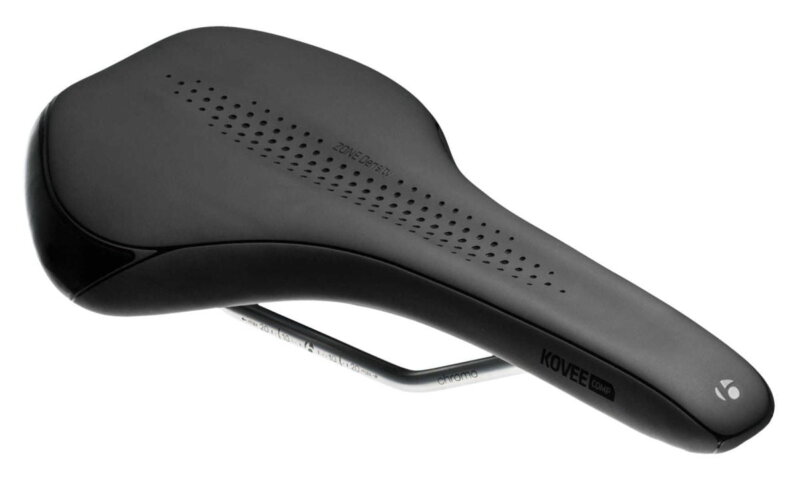After a post about bicycle saddle materials, this post focuses on the saddle padding – it’s thickness and softness – and how to choose optimal padding type.
1. Too soft saddle can, and does hurt
Many cyclists, in order to find a comfortable saddle, make the mistake of choosing one with a too soft (and often too thick) padding. The problem with thisk soft padding is that, especially after a longer ride, it becomes uncomfortable – like a sofa that is too soft. How come?
After some riding time, muscles get stronger and used to the saddle. Then, a saddle that is too soft won’t provide support in the seat bone area, but gets squiched and puts pressure in the soft tissue are (prostate for men).

Seat bone area (red) and pubic area (green).
Source: www.sq-lab.com

Saddle that is too soft (left)
Firm saddle (right)
Source: https://www.cervelo.com
In addition to not supporting weight properly, too soft padding chafes on the body while legs are moving during pedalling, causing more discomfort.
However, for short rides, especially if a rider isn’t very fit, or used to sitting on a saddle, a soft padded one could be a good choice. Although it often happens that at the beginning of the “season”, people buy a soft saddle – then, as they become more fit and start riding longer, they buy a new – less soft saddle. That is something to consider.
2. Too hard – the other extreme
The other extreme are saddles that are very hard, firm, almost without any padding. Such saddles can be a good choice for riders in good shape, riding in padded cycling shorts/tights. In fact, if riding in padded shorts, most saddle padding can be more harm than help (apart from adding needless weight). Padded shorts + hard saddle is usually more comfortable than a slightly softer saddle without a padded shorts.
The disadvantage of hard saddles is the afore mentioned – they get pretty uncomfortable without a padded shorts. That is why, for more leisured cycling (commuting, running errands etc.), or if one doesn’t ride in padded cycling clothes, it is often better to choose a saddle in between the two described extremes – neither too soft to cause discomfort, nor too hard to require special padded clothing.
Bicycle saddle shapes and their effect on comfort is explained in this post:
Bicycle saddle (seat) shape
3. Bicycle saddle model recommendations
Before buying, I would recommend reading all 5 short articles in this series (this one is 2nd):
- Bicycle saddle fit [01] Materials they are made of
- Bicycle saddle fit [02] Saddle padding
- Bicycle saddle fit [03] Saddle shape
- Bicycle saddle fit [04] Measuring sit bone width
- Bicycle saddle fit [05] Optimal saddle width
- My bicycle saddle is uncomfortable, what should I do?
If concrete model recommendations help you, these have worked very well for me over the years (Amazon affiliate links will be used, so you can check the prices and availability with one click):
An excellent MTB saddle is Selle Royal model Suez.

A rather athletic saddle, but its padding is not too hard, so they are comfortable even without the use of padded cycling shorts (bibs) – Amazon affiliate link. It is cut out in the middle, to eliminate any pressure on the “sensitive parts” of both men and women (for the latter claim I’m relying on the feedback I got from female cyclists who have used this model – just look at my pronouns 🙂 ).
An excellent saddle for city bicycles (and all the others with a more upright sitting position), is Brooks model Flyer.

Brooks Flyer is a bit heavier (steel frame, with leather). But thanks to its shape, and the springs at the rear, it is very comfortable, even on extremely long rides (cyclo-touring etc.). Springs are very hard, so you won’t be bouncing when pedalling, but they will absorb any harsh road shocks (bumps, potholes). The leather is great for the summer, but can feel a bit colder in the winter (compared to synthetic materials), and it can get soaked if left in the rain. So I’d avoid this for very wet, or cold climates.
Finally, a road bicycle recommendation – Fizik Antares R3 Open K:IUM Regular black

Last updated:
Originally published:

